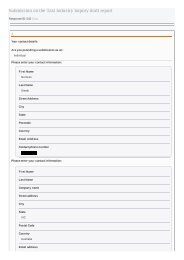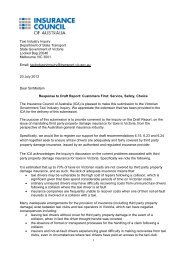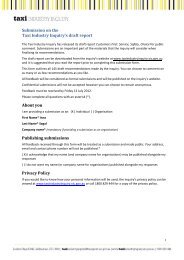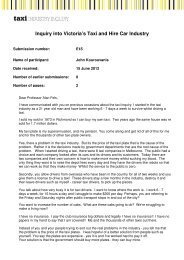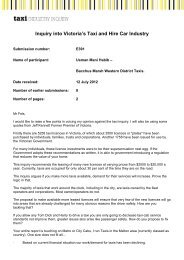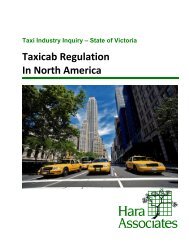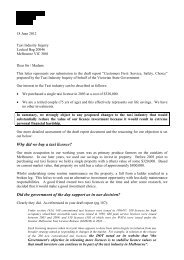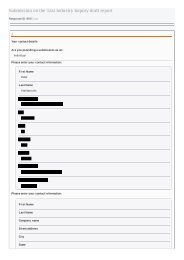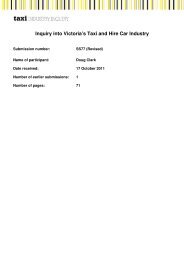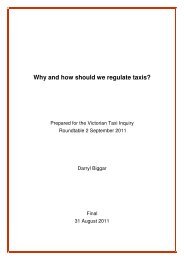Part D â Understanding and improving industry performance (PDF ...
Part D â Understanding and improving industry performance (PDF ...
Part D â Understanding and improving industry performance (PDF ...
Create successful ePaper yourself
Turn your PDF publications into a flip-book with our unique Google optimized e-Paper software.
A further example is the decision to release 330 new<br />
WAT licences. This decision followed a recommendation<br />
from the ESC that 15 per cent of the fleet should be<br />
wheelchair accessible <strong>and</strong> that meeting this goal would<br />
require an additional 330 WATs. However, the ESC<br />
also stated that <strong>performance</strong> monitoring should be<br />
undertaken <strong>and</strong> “if <strong>performance</strong> monitoring reveals that<br />
there are significant differences in the level of service<br />
being provided to WAT users <strong>and</strong> other taxi customers,<br />
further WAT licences should be released until this<br />
difference is removed.” 34 The inquiry underst<strong>and</strong>s that<br />
this <strong>performance</strong> monitoring is not linked to further<br />
licence releases in any quantifiable way in metropolitan<br />
areas, although it may be used by the VTD in determining<br />
whether issuing further licences might be in the public<br />
interest in country areas.<br />
A particularly concerning feature of recent licence<br />
releases is that, other than WAT <strong>performance</strong> data, there<br />
is no reliable information collected about waiting times<br />
for consumers or of the financial state of the <strong>industry</strong><br />
(other than assignment prices). This makes it very difficult<br />
to predict the effect of new licence releases on either<br />
consumers or operators. Other states in Australia have<br />
models in place that at least provide some predictable<br />
‘triggers’ for the release of new licences, using relevant<br />
<strong>industry</strong> data.<br />
Internationally, a field of inquiry based on estimating<br />
“significant unmet dem<strong>and</strong>” has also developed. This<br />
has primarily come from the UK, where local authorities<br />
have the power to restrict entry in certain circumstances.<br />
Commonly, studies of significant unmet dem<strong>and</strong> are<br />
undertaken which estimate that unmet dem<strong>and</strong> as a<br />
function of:<br />
• Passenger delay during normal times during the week<br />
• Passenger delay during peak dem<strong>and</strong> periods<br />
• Latent dem<strong>and</strong>, estimated by asking consumers<br />
whether they have been dissuaded from attempting<br />
to procure a taxi due to concerns about availability.<br />
On the one h<strong>and</strong>, the collection of information about these<br />
variables is a significant improvement on what is done in<br />
Victoria. It would lead to more informed conclusions about<br />
the true state of dem<strong>and</strong> in a market. Judgements on this<br />
basis would be more transparent. Nonetheless, it may also<br />
be subject to the criticism that it assumes a regulator can<br />
better determine market dem<strong>and</strong> that investors who are<br />
willing to risk their capital that a profit is there to be made.<br />
There is no strong basis for the use of any particular index<br />
or group of indexes; how should one weight the interests<br />
of users at peak times against those of the <strong>industry</strong> at offpeak<br />
times?<br />
When does waiting time become “too high”? A marketbased<br />
approach would offer a much less information<br />
intensive approach <strong>and</strong> one that leaves commercial<br />
judgements in the h<strong>and</strong>s of those in the <strong>industry</strong>.<br />
What’s happening in other places?<br />
New South Wales<br />
In late 2009, the NSW Government introduced<br />
major changes to taxi licensing in Sydney. The<br />
new supply-based model for taxi licence release in<br />
Sydney requires the Director-General of Transport<br />
NSW to determine the number of annual taxi<br />
licences, excluding wheelchair accessible taxis, to<br />
be released each year. The model takes account<br />
of various dem<strong>and</strong> factors, including growth in<br />
State final dem<strong>and</strong>, population, the unemployment<br />
rate, airport passenger numbers, real value of<br />
licences, network bookings <strong>and</strong> other <strong>performance</strong><br />
measures. WAT licences are available at all times<br />
for $1,000 per annum.<br />
Western Australia<br />
In 2004, the Western Australia Government began<br />
to lease new licences instead of releasing them<br />
to the market. This aimed to address availability<br />
issues <strong>and</strong> to stimulate additional competition in<br />
the <strong>industry</strong>. The Government determines a number<br />
of licences to be leased each year based on a<br />
dem<strong>and</strong> formula which primarily takes into account<br />
waiting times <strong>and</strong> ‘no shows’. This dem<strong>and</strong><br />
based formula is intended to provide incentives<br />
to taxi operators/drivers to improve services via<br />
increased availability <strong>and</strong> reliability, as the risk of<br />
non-<strong>performance</strong> by operators/drivers is a release<br />
of more licences <strong>and</strong> thus more competition.<br />
Tasmania<br />
From 2006 to 2007, the Tasmanian Government<br />
undertook a review of taxi <strong>industry</strong> legislation. The<br />
result was a significant change to taxi licensing<br />
arrangements. The intention of the changes was<br />
to shift the <strong>industry</strong> focus to service provision <strong>and</strong><br />
away from investment in licences as assets. As<br />
such, new licences issued are non-assignable<br />
owner-operator licences. These new licences are<br />
made available via a tender process <strong>and</strong> the sale<br />
price must be greater than a predetermined reserve<br />
price. A maximum of five per cent of the number<br />
of current licences on issue can be released in<br />
a single year, <strong>and</strong> at least one licence must be<br />
released in the year.<br />
34 ESC (2008b), Final Report – Taxi Fare Review 2007/2008,<br />
Melbourne, p.34<br />
188




